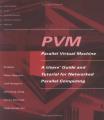
Parallel Algorithms
by Henri Casanova, et al.
Publisher: CRC Press 2008
Number of pages: 348
Description:
The aim of this book is to provide a rigorous yet accessible treatment of parallel algorithms, including theoretical models of parallel computation, parallel algorithm design for homogeneous and heterogeneous platforms, complexity and performance analysis, and fundamental notions of scheduling. The focus is on algorithms for distributed-memory parallel architectures in which computing elements communicate by exchanging messages.
Download or read it online for free here:
Download link
(2.8MB, PDF)
Similar books
 Programming on Parallel Machines
Programming on Parallel Machinesby Norm Matlo ff - University of California, Davis
This book is aimed more on the practical end of things, real code is featured throughout. The emphasis is on clarity of the techniques and languages used. It is assumed that the student is reasonably adept in programming and linear algebra.
(8760 views)
 Vector Models for Data-Parallel Computing
Vector Models for Data-Parallel Computingby Guy Blelloch - The MIT Press
Vector Models for Data-Parallel Computing describes a model of parallelism that extends and formalizes the Data-Parallel model on which the Connection Machine and other supercomputers are based. It presents many algorithms based on the model.
(11913 views)
 The Practice of Parallel Programming
The Practice of Parallel Programmingby Sergey A. Babkin - CreateSpace
This book provides an advanced guide to the issues of the parallel and multithreaded programming. It goes beyond the high-level design of the applications, into the details that are often overlooked but vital to make the programs work.
(21064 views)
 PVM: Parallel Virtual Machine
PVM: Parallel Virtual Machineby Al Geist, at al. - The MIT Press
Written by the team that developed the software, this tutorial is the definitive resource for scientists, engineers, and other computer users who want to use PVM to increase the flexibility and power of their high-performance computing resources.
(12050 views)